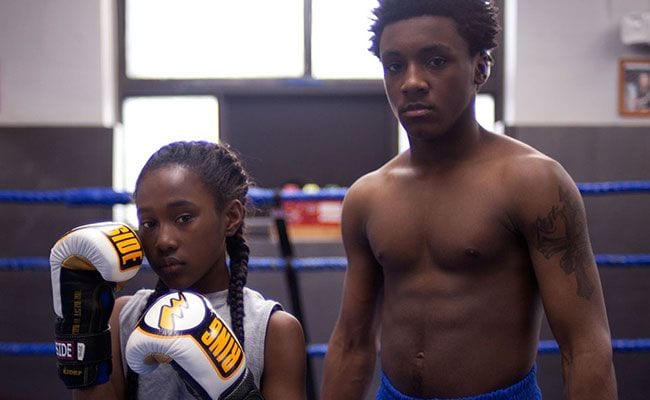
“[Royalty] had almost no lines in the script and she crossed out about half of the lines that she had, so she had even fewer lines. And she was like, I’m already saying this, this, this, and this, I don’t need to vocalize it.”
The Fits begins with breathing. Toni (Royalty Hightower) is doing sit-ups, looking directly into the camera when her face comes into frame, then disappears as she lays back on the mat. She breathes and she counts. Her knees poke up into the bottom of the shot while a blurry pair of boxers — their lower halves, anyway — are behind her.
Toni is 11 years old, training with her older brother Jermaine (Da’Sean Minor), a junior boxing champion. In these first moments, you see that she’s fierce, that she’s focused. In the scene following, Toni jabs at her brother’s punch mitts as he instructs, encourages, and tests her. Toni doesn’t talk much, but keeps moving, the camera bobbing with her.
In these first couple of minutes of The Fits, set in Cincinnati, you might see a familiar set-up for a girl’s coming of age, a story of strength and resolve, a story about resistance to some norms that conforms to other norms. This is only partly right. At first, Toni is a girl making her way through a boys’ world, determined, competitive, and thoughtful, too. In the next scene, however, the film’s direction changes, as Toni absorbs a new set of challenges, embodied now not only by boys so obviously baffled by her, but also by girls, specifically, girls in a dance squad, the Lionesses, training for competition.
You can see how Toni’s attracted to this group, their moves precise, their limbs fluid, hair flying. You can see this even as she barely speaks, because the camera in The Fits, directed by Anna Rose Helmer and shot by Paul Yee, indicates Toni’s view and her place, in space and also in time, her immediate horizons and also her yearning. Even in the first scene in the boxing gym, her curiosity is clear when the scene cuts from Toni as she unwraps her hands in the foreground as Main and his friend Donte (Antonio A.B. Grant Jr.) lift weights, mirroring each other and looking like rockem-sockem robot bookends behind her.
Suddenly, Toni and you are distracted by knocking. A cut to the gym door shows a girl in the window: it’s Legs (Makyla Burnam), identified by Donte as captain of the dance team, come to check him out, “peeping”. Intrigued, you follow Toni to the dance team’s practice. She gets there by way of sound and motion, the film’s thematic abstractions made material and mesmerizing. She’s lugging and rolling a water jug up a slight upgrade, the camera hovering over her back as she makes her way, slowly, as she’s drawn by the sound of music, percussive, echoey. She peeps now, her view limited by the narrow window in the door to the practice space, the girls in motion and together. It’s like she’s seen another life.
Their appeal is made visceral here. Not only are they lovely and collective, not only are they intense, but they are also loud, in sync with and identified by throbbing dance music. Toni’s own experience, sometimes excruciating internal but also turned outward, so you see her even as you see what she sees, the camera tacking her, approximating her perspective, looking back at her amazed face, which is at once a sort of seduction and also a plunge into the unknown, is characterized by Danny Bensi and Saunder Jurriaas’ score, including spare clarinet and percussion, haunting and propulsive. It pulls you forward and also imagines pauses, gaps in time and feeling.
All these elements provide a framework for The Fits‘ increasingly unusual plot, which leads Toni on a journey from the boxing gym to the dance team, to find herself in between those options, and in both. Most especially, she finds herself in her body, an experience shown here by “the fits”, a convulsive kind of seizure that overcomes the girls on the team one by one. The adults, who tend to appear at frames’ edges or in shallow-focused backgrounds, suggest it might be caused by the school’s water supply, encouraging the girls to use the boxing gym’s bottled water.
The girls, in turn, worry and whisper about it, then witness it: Toni and her new friends Beezy (Alexis Neblett) and Maia (Lauren Gibson) see girls’ bodies twist and shake, their heads thrown back. You’ll never know if its causes are medical or social or both, but the sight of the fits is entrancing: some girls shake violently, others look transported, ethereal. And as you observe with Toni, you see her fear, as she exits the scene, turns away, or even closes a door on one friend in the throes. But like her 11-year-old self, you’re less inclined to pursue reasons for the transformation than to feel transfixed by it. Like her. You don’t exactly choose how to see the fits, but looking away becomes increasingly impossible.
However you might read the fits, as metaphor or study, science-y fiction or an especially poetic form of documentary, The Fits helps you to see an emerging sense of independence as you might remember it, but also, as you haven’t imagined it before. In Toni, a girl who comes of age, who comes into herself, the movie offers a brilliant, new, and sensory experience, one that helps you to perceive nuances of sight and sound, to appreciate how bodies shape your relationship to the world, to time and space.


![Call for Papers: All Things Reconsidered [MUSIC] May-August 2024](https://www.popmatters.com/wp-content/uploads/2024/04/all-things-reconsidered-call-music-may-2024-720x380.jpg)



